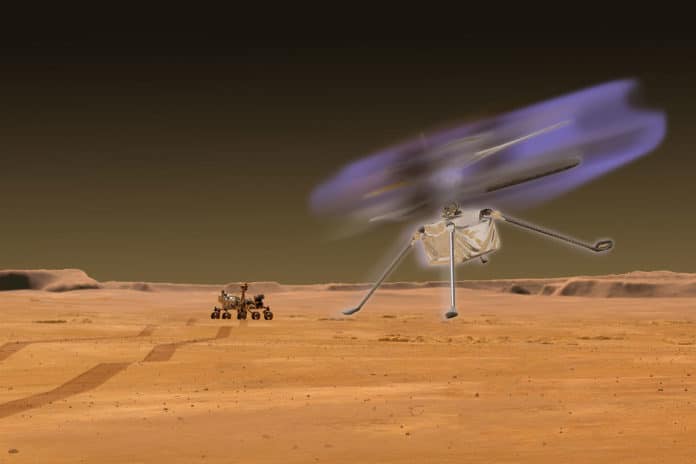Helicopters flying on Mars may glow at night due to a strange effect from the Martian atmosphere. According to a NASA study, the whirling blades on drones flying above the Red Planet may cause tiny electric currents to flow in the Martian atmosphere, which might cause the air surrounding the craft to faintly glow.
The same process also occurs naturally on Earth as a corona or electrical glow, sometimes seen on aircraft and ships in electrical storms known as Saint Elmo’s Fire.
This glowing effect is due to triboelectric charging, which happens when friction transfers electric charge between objects, like when a person rubs a balloon against their hair or sweater. The electrified balloon will attract the person’s hair, causing it to lift toward the balloon, indicating that the balloon has developed a large electric field from the triboelectric charging process.
The research team applied laboratory measurements and used computer modeling to investigate how electric charge could build upon a drone’s rotor blades. Charge build-up also happens on terrestrial helicopter blades, especially in dusty environments, so the team also used interpretations and modeling of the charging from terrestrial helicopters as a basis for understanding the Mars case.
The study suggests that as the drone‘s blades spin, they run into tiny dust grains in the Martian air, especially when the craft is at low altitudes. As the blades impact the grains, the charge is transferred, building upon the blades and creating an electric field. As charge builds to high levels, the atmosphere starts to conduct electricity, creating a population of electrons that form an enhanced electric current that acts to dissipate or offset the charge build-up on the rotorcraft.
“The faint glow would be most visible during evening hours when the background sky is darker,” said William Farrell of NASA’s Goddard Space Flight Center in Greenbelt, Maryland, lead author of a paper on this research. “NASA’s experimental Ingenuity helicopter does not fly during this time, but future drones could be cleared for the evening flight and look for this glow.”
The electric currents generated by the fast-rotating blades on drones are too small to be a threat to the craft or the Martian environment. But they might be large enough to cause the air around the blades and other parts of the craft to begin the electron avalanche and possibly even glow a blue-purple color.
However, the researchers acknowledge that their result is a prediction, and sometimes nature has other plans. “In theory, there should be some effect, but whether the electron avalanche is strong enough to create a glow, and if any weak glow is observable during operations all remain to be determined in future drone flights on Mars,” says Farrell. “In fact, one could even place small electrometers up near the blade and at the legs to monitor the effects of any charging. This kind of electrical monitor could be of both scientific value and provide critical input on drone health during the flight.”
